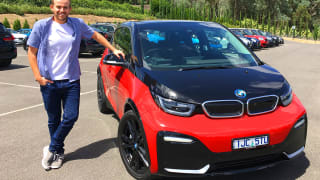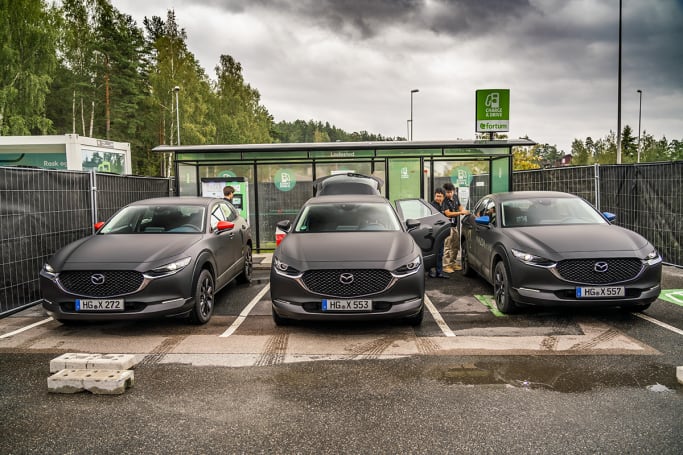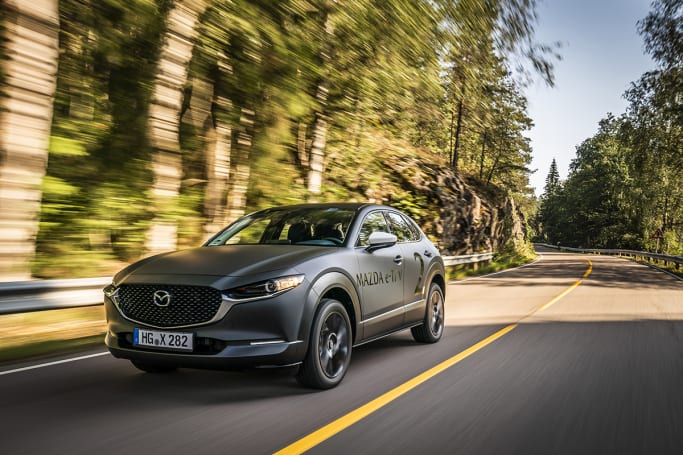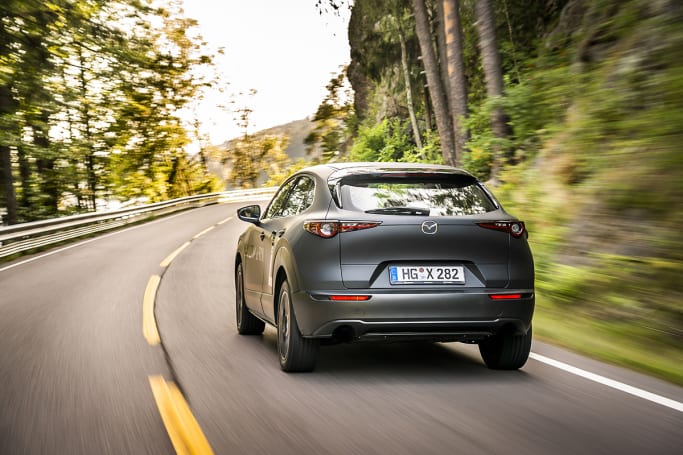
BMW i3s 2018 review
The 2018 BMW i3s is focused on enhancing the drive experience - making it sportier and more involving, grippier and more powerful. The cost of the upgrades is pretty minimal, but definitely worthwhile
Browse over 9,000 car reviews
Mazda has always seemed somewhat reluctant to jump on the electrified bandwagon, long arguing that it makes more sense to reduce the CO2 emissions coming out of the cars that people are still buying, right now, instead of focusing on some far-off future.
And now the tech-savvy Japanese company has finally unveiled its first EV, an as-yet-unnamed, small SUV-sized city vehicle, which it launched in the global epicentre of electric-vehicle usage, Norway - where more than 55 per cent of all new cars sold are now EV, and the government is aiming for that figure to hit 100 per cent by 2025.
Mazda knows it has to offer something to countries like this, and other European nations that are cracking down on emissions, but it is extremely realistic about how many cars it will sell, globally, with some form of internal-combustion engine still attached. It’s tipping this BEV will make up just 5 per cent of its sales by 2030, with the rest being hybrids, plug-in hybrids or range extenders (it’s working on an exciting rotary-powered range extender already).
That doesn’t mean it’s holding anything back with its first full EV, however, and it promises this car, which we drove in prototype form, hidden under the skin of a Mazda CX-30, will deliver “driving joy”.
We were keen to find out. Keen enough to fly all the way to Oslo.
Obviously we'll have to wait until the Tokyo Motor Show, when the production version will be revealed, but we do know that it will use Mazda's excellent Kodo design language, which has pretty much reached a new high with the latest Mazda 3.

All Mazda will tell us about the EV is that it will use this design language in a new and exciting way. You can bet, then, that this car will look very different from other Mazdas, and will immediately stick out as an electric vehicle.
Mazda won't say for sure what size the new EV will be, but the fact that they chose to let us a drive the platform with a CX-30 body on top suggests that it will be a small, city-sized SUV, and this seems more likely than a Mazda 2-style of vehicle, because SUVs are what buyers want, no matter their motive force.

Mazda's goal is to reduce CO2 emissions globally and it's been doing a lot of maths. It calculates that, when you take into account the full life-cycle of an EV, from extracting the materials to build it to recycling the. battery and so forth, the most emissions-friendly solution is to give it the smallest battery possible.

So its first EV is asked to make do with a 35kWh battery attached to an AC synchronous motor with 355 volts. Its output is 105kW and 265Nm, which seems adequate on paper and feels more than adequate on the road. It also gets a single-speed transmission, which makes for seamless and hugely entertaining acceleration.
Obviously you'll consume no fuel at all, although it's worth noting that if you charge this car using a typical, coal-fired Australian power plant, your EV will effectively be producing around 220g per km of CO2, according to Mazda, which is not good at all.
People who buy one in Tasmania, with its clean hydro power, or who have their own solar panels and a (Tesla) power wall can feel far more virtuous.

The bigger problem is range. With this size battery, the Mazda will probably only offer 250km, or 300km at best, and that's the trade-off the company is asking buyers to make. Explaining the life-cycle argument will be key, but selling range extenders and hybrids will probably be easier, at least in countries like Australia.
It’s fair to say that if this new Mazda was the first EV you’d ever driven, you might be almost disappointed in how normal and familiar it feels. Anyone who has driven other electric vehicles, however, would find it revelatory.
EVs are not normally like ICE cars to drive, for a few important reasons, but the most noticeable is that you barely need to use the brakes in general driving, because you get so much deceleration effect every time you lift your foot off the throttle. This regenerative-braking effect is like engine braking, times 100.
As Mazda’s engineers have deduced, this feels weird and unnatural and takes some getting used to. Some people love it, others don’t but it’s hard to argue with the Mazda folks’ assertion that what helps a human being’s posture, when a vehicle is slowing, is to brace themselves, using the brake pedal.
Older drivers in particular find the ergonomic weirdness of not using the brakes much in EVs quite unsettling, apparently.

What you notice immediately about this Mazda prototype’s approach is how normal, and ICE-like, it is to drive, in terms of the way you need to dab the brakes to tip it into corners, or really squeeze them on the way into hairpins.
Mazda tells us the car is still getting the benefits of regeneration from the brakes, and when you step off the accelerator, it’s just that they have decided this is the best way to help you feel what the car is doing. And it works, brilliantly.
Another approach that sets this Mazda BEV apart is using noises - albeit fake ones, pumped through the speakers at suitably low volumes for an EV - to help tell you what the motors are up to. Again, it feels familiar, and comfortable, although the choice of sounds - a combination of sci-fi whining, zipping and bubbling with faux revving noises - takes some getting used to.
What is still very much in evidence, however, is the massive, and always instantly available, torque shove that you get from EVs. And the seamless acceleration they achieve by having only one gear.

With just 105kW and 265Nm of torque, the Mazda isn’t hugely quick, and we’ll have to wait and see how heavy the actual road car is, but it’s still a lot more fun than a petrol-chugging car in almost all situations.
While the steering felt overly light and disconnected to me (something that may well yet be adjusted for the final version), the way this thing rode and handled was excellent. Mazda has been able to apply a new version of its torque-vectoring software to this car, which allows it to apply torque where it’s needed, even when you’re not using the throttle, which is very clever.
There’s also an admirable lack of pitching and diving, and the chassis, which incorporates the battery housing as a stressed member, feels super stiff as well.

Through fast sweepers and changes of direction it felt genuinely sporty, involving and hugely fun.
We can’t be sure until we drive the road-going version, of course, but all the indicators from our prototype experience are certainly pointing in the right direction.
Let’s just hope this thing actually comes to Australia. I’ve got a sneaking suspicion that it will.
$26,888 - $37,990
Based on 33 car listings in the last 6 months
This really is a game-changer of an EV, because it's so different to drive than others that have so far come to market. It's car-like, and genuinely fun to throw around, and the fake noises it makes are a strangely welcome touch, too.
Let's hope it does come to Australia, because it's an EV that could change a lot of people's minds. It made me feel a lot better about our driving future.
Note: CarsGuide attended this event as a guest of the manufacturer, with travel and meals provided.
$26,888 - $37,990
Based on 33 car listings in the last 6 months